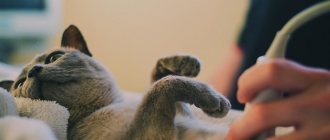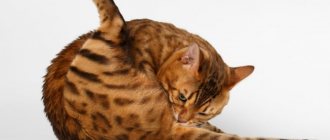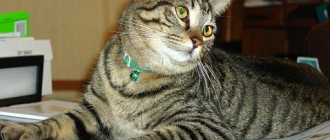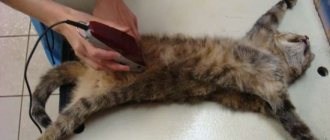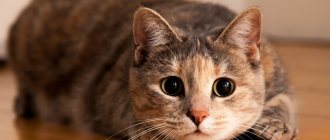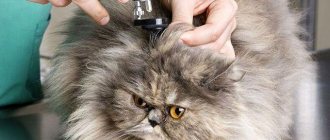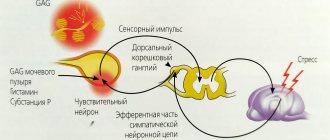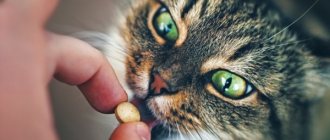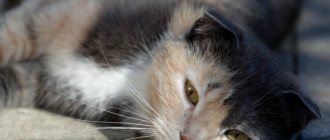Causes of the disease
Intestinal obstruction can be caused by numerous factors. The reasons causing stagnant processes include the following:
- Entry into the intestines of foreign objects that the cat can accidentally swallow, and hair that gets into the organ when licking. This reason is the most common - up to 80% of all cases.
- Infection with helminths. Live and dead worms in excessive quantities form into clumps that completely block the intestinal lumen.
- Coprostasis observed over a long period of time. Dry feces form a dense plug that closes the intestines. Constipation is most often a consequence of poor diet. Undigested food and decay products, among other things, also poison the animal’s body.
- Volvulus. A constriction that occurs in a certain area of the intestine disrupts blood circulation, as a result of which the organ dies and decomposes.
- Intussusception. It is a consequence of intestinal volvulus and is characterized by the penetration of one intestine into another.
- Malignant and benign neoplasms in the intestine. First, tumors provoke a partial blockage, then, as they grow, they cause a complete blockage.
- Intestinal paralysis. The cause of organ paralysis may be injury to the spine, intestines, diseases of the nervous system, etc.
Regardless of the factor that caused ileus, measures to eliminate intestinal obstruction should be taken immediately.
Prevention measures
To avoid the development of intestinal obstruction in your pet, you must follow the following preventive measures:
- Monitor the quality and diet of the cat. If the animal eats special food, it is better to choose one that has the ability to gently remove hair from the gastrointestinal tract. You also need to remember that your cat should always have access to a sufficient amount of clean drinking water.
Proper nutrition
- Cats walking outside clear their stomachs of accumulated hair by eating grass and causing vomiting. If your pet does not go outside, you should provide it with special grass produced for this purpose.
- It is necessary to supervise the cat and not allow it to play with small objects that it might swallow.
Attention! Plastic bags, candy wrappers, and foil are especially dangerous, since these items can easily get stuck in the intestinal lumen due to their friability and are completely indigestible.
- Regular deworming will help avoid the accumulation of parasites in the intestines.
Which breeds are more susceptible
Ileus can occur in any cat, regardless of age or gender. Representatives of long-haired breeds, for example, Persians, Siberians, Maine Coons, are most susceptible to this phenomenon. Numerous hair that enters the stomach during licking forms trichobezoars - dense hairballs. They are the most common cause of intestinal obstruction.
Preventive measures
Prevention consists of following simple rules:
- do not allow the cat to chew on foreign objects;
- feed the animal on time, adhere to the correct diet;
- prevent the presence of inedible objects in the animal’s free access.
Expert opinion
Burmistrova Alena Valerievna
Breeder, 7 years experience.
It is important to brush your pet regularly so that during licking less hair gets into the intestines.
Main symptoms
At the initial stage, ileus obstruction practically does not appear. Signs such as nausea, constipation, and bloating should alert the owner.
As the disease progresses, the cat stops showing interest in food and does not drink. This is due to the fact that the stomach does not empty and becomes larger due to undigested food. Nausea progresses to vomiting, attacks of which occur every 15-20 minutes. Vomit sometimes contains stool particles.
There is no chair. At the onset of the disease or in case of partial obstruction, small passages of feces formed before the intestinal blockage are possible.
Due to the fact that gases do not escape, the cat's stomach becomes bloated. The pet constantly licks it, feeling severe pain. Fluffy doesn't allow you to touch his belly.
During palpation, you can feel the tension and hardness of the abdominal cavity; sometimes a foreign body that the cat has swallowed can be felt.
Diagnosis of intestinal obstruction in a cat
Intestinal obstruction in cats is a very dangerous condition that can quickly lead to the death of the animal. That is why, when the first symptoms appear, the cat must be immediately shown to a doctor. It should be noted that intestinal blockage is not very easy to diagnose. To begin, the veterinarian will conduct an external examination and palpate the abdomen. In some cases, during palpation you can even feel a foreign object blocking the intestines.
To diagnose intestinal obstruction in cats, the following methods are used:
- General blood and urine analysis. Helps determine the general condition of the animal and the degree of intoxication of the body.
- Caloscopy in case of partial obstruction.
- Ultrasound of the abdominal cavity. It does not always help determine obstruction, but this study is useful if there is inflammation or neoplasms in the intestinal tract.
- X-ray. Most often, the picture is taken using a contrast agent. X-rays help determine which part of the intestine is dilated due to accumulated gases and feces, which is the main sign of obstruction.
But still, in most cases, the above methods are ineffective. Most often, a trial surgical intervention - laparoscopy - helps to make an accurate diagnosis. It is done under general anesthesia. If intestinal blockage is accurately diagnosed, then laparoscopy develops into a full-fledged operation.
Possible consequences of intestinal obstruction
In most cases, a cat with an intestinal blockage will need immediate surgery. If the diagnosis was made correctly and on time, the animal will recover very quickly.
You might be interested in: A cat was bitten by a tick: how to help your pet?
If timely assistance is not provided, the cat will die within a couple of days due to dehydration and intoxication. With partial obstruction, the animal's suffering can last a couple of weeks until a complete blockage of the intestines occurs.
Intestinal obstruction is not a situation where everything can be resolved by itself. This is why it is important to immediately show the animal to a veterinarian when the first symptoms occur.
Diagnostics in a veterinary clinic
To make a diagnosis, the veterinarian examines the animal, studies the medical history, and also prescribes the necessary diagnostic measures. To determine the severity of intoxication, the cat's urine and blood are examined.
X-rays with a contrast agent and ultrasound are not advisable, since the studies do not give an accurate result.
The only complete and informative diagnostic method for blockage of the intestinal lumen is laparotomy.
Treatment method and prognosis
There is no single treatment regimen for ileus. In addition, it is necessary to determine in which part of the intestine stagnation has formed. Only laparotomy can show this.
Important: stagnation in the small intestine is most dangerous. Under water pressure, the intestinal wall can rupture, leading to immediate death.
Treatment for intestinal obstruction includes two stages:
- laparotomy, which is regarded as a full-fledged operation;
- rehabilitation period.
The postoperative period is of great importance. To make the recovery process as easy and quick as possible, the cat should not be fed for 48 hours; water should only be given every other day.
To stabilize the indication, restore water-salt balance and relieve intoxication, intravenous infusions of saline solutions are indicated. A course of antibiotic therapy is required.
Nutritional adjustments are necessary. As a therapeutic diet, the special food Waltham Convalescence diet has proven itself well, which satisfies all the needs of the operated animal.
Medicinal and cleansing enemas using medicinal plants will help remove the irritating effect from the intestinal walls. It is acceptable to use linseed oil and vaseline oil. With the help of painkillers and anti-inflammatory medications, pain is eliminated and the inflammatory process is relieved.
To strengthen the immune system, restore microflora and support general condition, it is advisable to use probiotics and immunostimulants.
Treatment of intestinal obstruction in cats
The main mistake with intestinal obstruction in a cat is self-medication. It often causes even more harm, leading to a significant deterioration in the animal’s condition. If a cat stops eating and drinking, the owners try to force feed it. This leads to increased vomiting and dehydration.
If you have intestinal obstruction, you cannot feed or water your cat. Often, owners can give the animal anti-poisoning medications, which later makes it more difficult to make a correct diagnosis.
In this case, an enema is no less dangerous. Since intestinal blockage is often confused with constipation, owners can use this method to help their pet. An enema given for obstruction can lead to rupture of the intestinal walls. Because of this, the animal can die very quickly.
Vaseline oil, which is used for constipation, is also contraindicated for intestinal obstruction. It will only further complicate bowel function. In some cases, petroleum jelly can push a stuck foreign object further down the intestine, causing damage to its walls. Thus, you should not self-medicate. You need to listen to your doctor. After making an accurate diagnosis, strictly follow all its instructions.
In some cases, you can do without surgery and limit yourself to only conservative treatment. This method is used for partial intestinal obstruction. In this case, an enema or medications may be prescribed.
Often, surgery is still necessary. Often in its process it is necessary to remove the part of the intestine where necrosis began. Afterwards, stitches are applied, which can be removed after 14 days.
Sometimes the operation is complicated if the object that entered the body had sharp edges. Then there may be damage to the intestinal walls and internal bleeding, which must be stopped. There have been cases when cats swallowed threads with a needle, and stitching of the intestines occurred.
Caring for your cat after surgery
After surgery, the cat should not be fed for two days or given water for 24 hours. To avoid dehydration, saline is injected into the animal through a dropper. In some cases, your doctor may prescribe antibiotics to avoid complications caused by various infections.
The first time after surgery, the cat needs rest. A special bandage is put on the animal to prevent the cat from licking the postoperative wound.
The cat is put on a special diet. Doctors advise giving your cat easily digestible natural food during this period. Food portions should not be large, but they should be given more often. Most often, low-fat fermented milk products and lean meat are introduced into the diet. Vitamins are also added to the diet.
It is important to identify and eliminate the cause that led to intestinal obstruction. If the blockage is caused by helminth infection or disruption of the gastrointestinal tract, it is necessary to address this problem after surgery.
You might be interested in: What causes a cat to develop a rash on its stomach?
To get rid of helminths, special drugs are used. A special diet and a complete review of the cat’s diet will help normalize metabolism.
What to do at home
The owner is required to follow the instructions of the specialist. It is strictly forbidden to prescribe medications to your cat yourself, or to reduce or increase the dosage. Self-medication is dangerous and can cause irreparable harm to your pet! Traditional methods (herbs, massages, etc.) can help with bloating, constipation, but not with ileus. It is impossible to get rid of this phenomenon at home.
If you suspect intestinal obstruction, you should immediately take your pet to a hospital or call a veterinarian at home. You cannot feed your pet or give it water before examination by a specialist! Food and water will only aggravate the situation and cause profuse vomiting, which can lead to dehydration.
You should not give laxatives, much less try to relieve your cat’s intestines with an enema. Cleansing procedures are prescribed by a veterinarian, taking into account the condition of the animal and confirmation that the enema will not lead to intestinal rupture.
First signs and general symptoms
The owner needs to pay attention and find out the cause of changes in the pet’s behavior in order to deal with the pathology as quickly as possible. The key symptoms of blockage are the absence of bowel movements, that is, constipation, and vomiting.
How can you tell if your cat has an intestinal obstruction?
External symptoms of intestinal obstruction in cats can easily be confused with the clinical picture of a viral disease. Such similarity can be dangerous for determining the diagnosis, so you should not make decisions about the use of medications on your own. If you notice the appearance of several signs at once, you need to contact a specialist:
- Vomiting, which is associated with the accumulation of fluid in the stomach. Digested food gets stuck in the passages, mixing with gastric juice. Overcrowding of the digestive tract leads to repeated vomiting and dehydration. The pet tries to drink, but it only gets worse.
- Refusal to eat. The animal wants to eat, but does not even accept its favorite treats, because it experiences pain in the abdominal cavity.
- Abdominal enlargement. This occurs due to the accumulation of excrement in the intestine. The walls of the organ stretch and the abdomen enlarges. This causes great discomfort and severe pain.
- The formation of gases is associated with the growth of pathogenic microorganisms inside the body. This becomes the result of the accumulation of decay products and subsequent intoxication.
- Repeated attempts to defecate without success. The pet often goes to the toilet, trying to get rid of discomfort. Unfortunately, attempts do not bring a positive result, but only increase the pain inside the abdomen.
One or more signs that appear in a pet are considered serious signals to contact a veterinarian. It is likely that an independent attempt to alleviate the pet’s condition will lead to deterioration in health. Treatment of intestinal obstruction in cats is based on symptoms.
What should the owner do in case of suspicion?
Stagnation in the large or small intestine can cause organ rupture. This almost immediately leads to the death of the patient. You should not use laxatives or give cleansing enemas - they increase the risk of rupture significantly. Antiemetics can reduce symptoms, but will not remove the root cause of the pathology. The only correct decision that the owner can make is a prompt visit to the veterinary clinic. It is advisable not to postpone the visit to a certain day, but to go to the veterinary hospital immediately after detecting alarming symptoms.
Possible complications
You need to understand that ileus is a very dangerous phenomenon. If left untreated, intestinal obstruction leads to disastrous consequences, including death. Feces, gases, and gastric juices accumulate in the intestines, as a result of which the blood supply is disrupted and necrosis (death of the intestinal walls) develops.
In addition, the body receives severe poisoning from decay products. This leads to the death of intestinal microflora and the development of putrefactive processes in the intestines.
The situation with partial ileus is somewhat simpler, when the intestinal lumen does not close completely, allowing gases and a small amount of feces to escape. However, this does not mean that treatment is not required.
Kinds
Veterinary clinic specialists distinguish two types of the condition.
Full
Complete compression occurs, blocking the intestinal lumen due to hair or foreign body entry.
In this case, gas or liquid is not able to escape, which leads to their accumulation inside the intestines. The blood supply is disrupted, necrosis and intoxication of the body begins to develop, and increased pressure is placed on the internal organs.
Partial
With partial obstruction, part of the lumen remains free. Feces and accumulated gases may be released. However, their removal is incomplete. Beneficial microflora begins to gradually be replaced by putrefactive bacteria.
